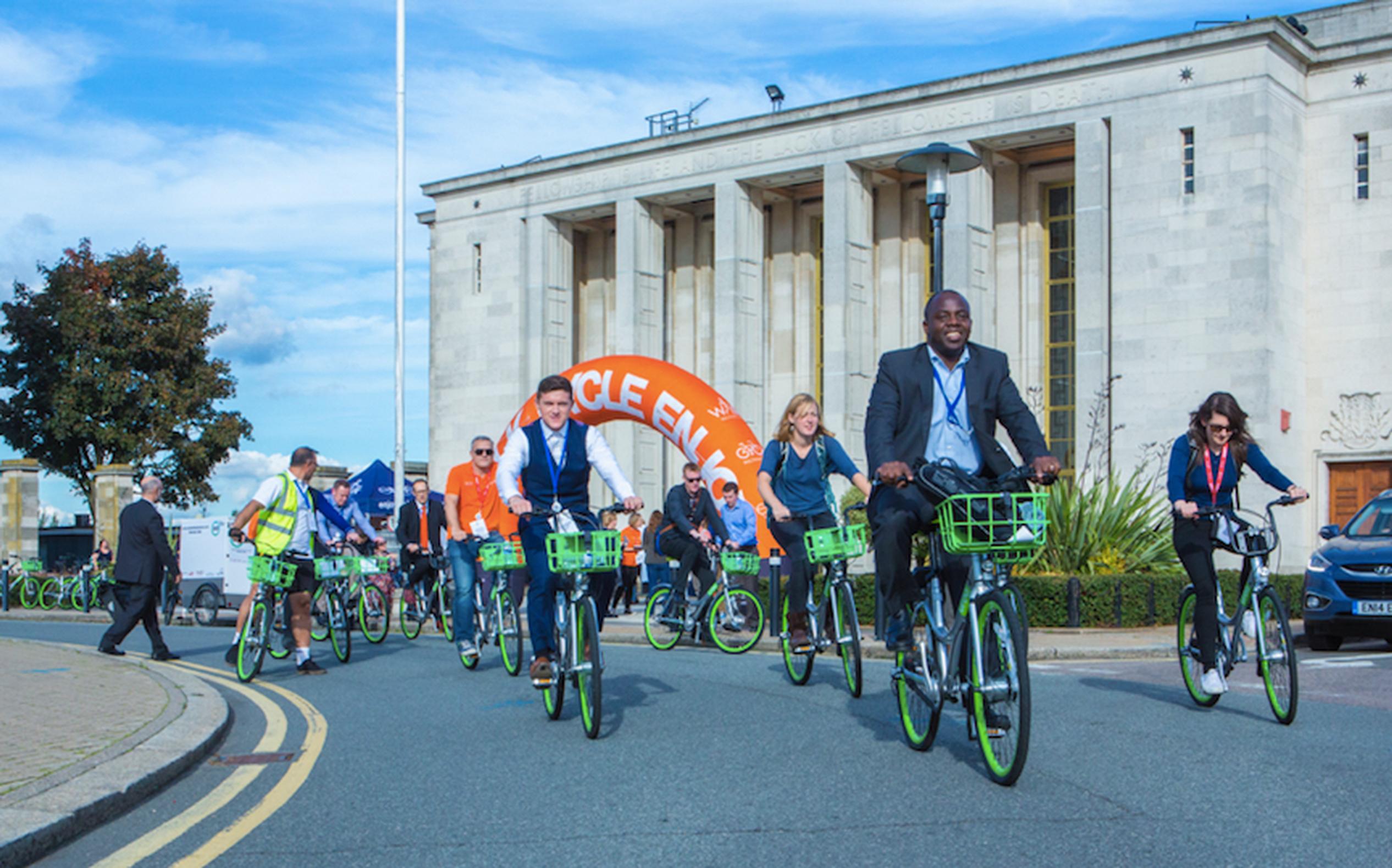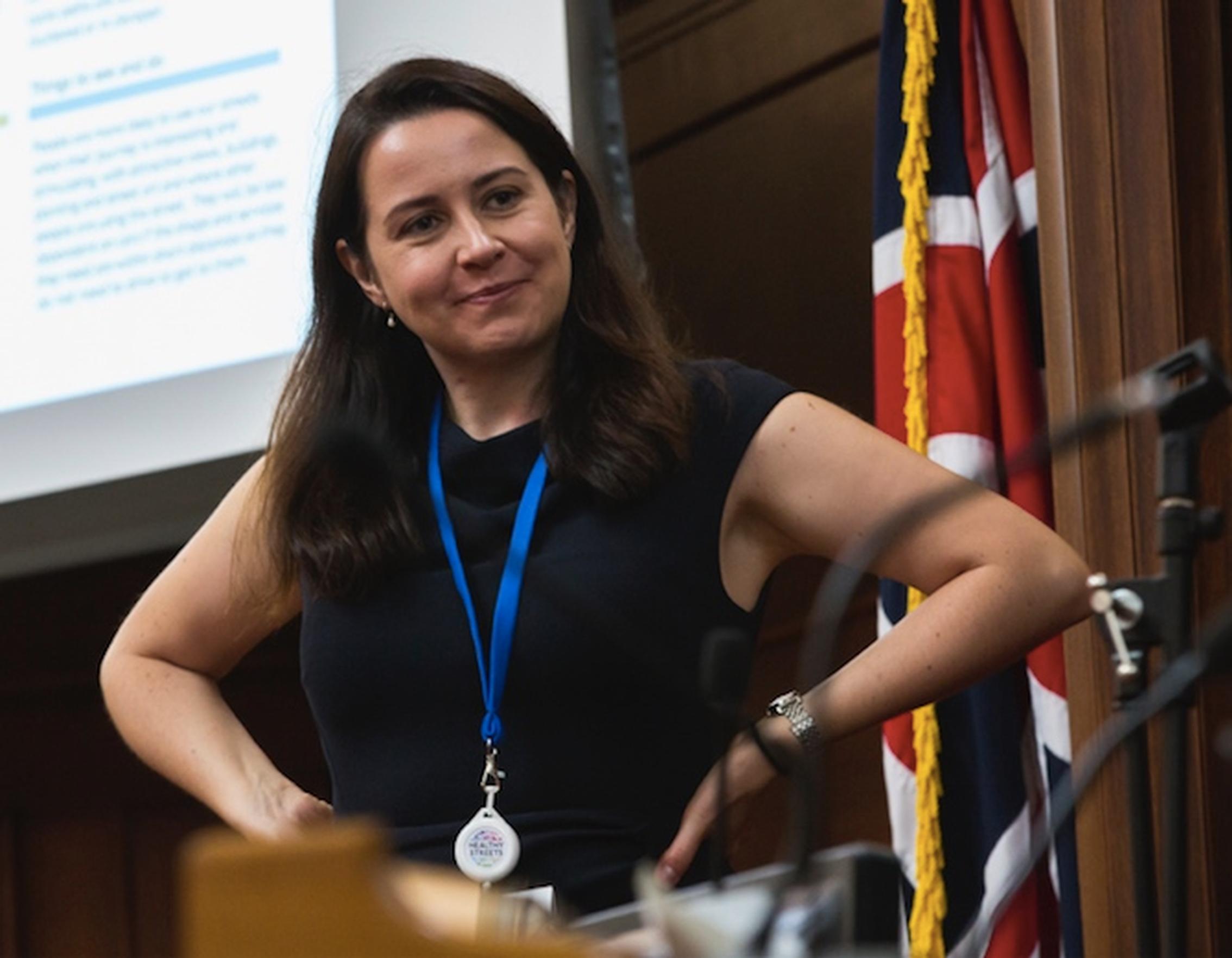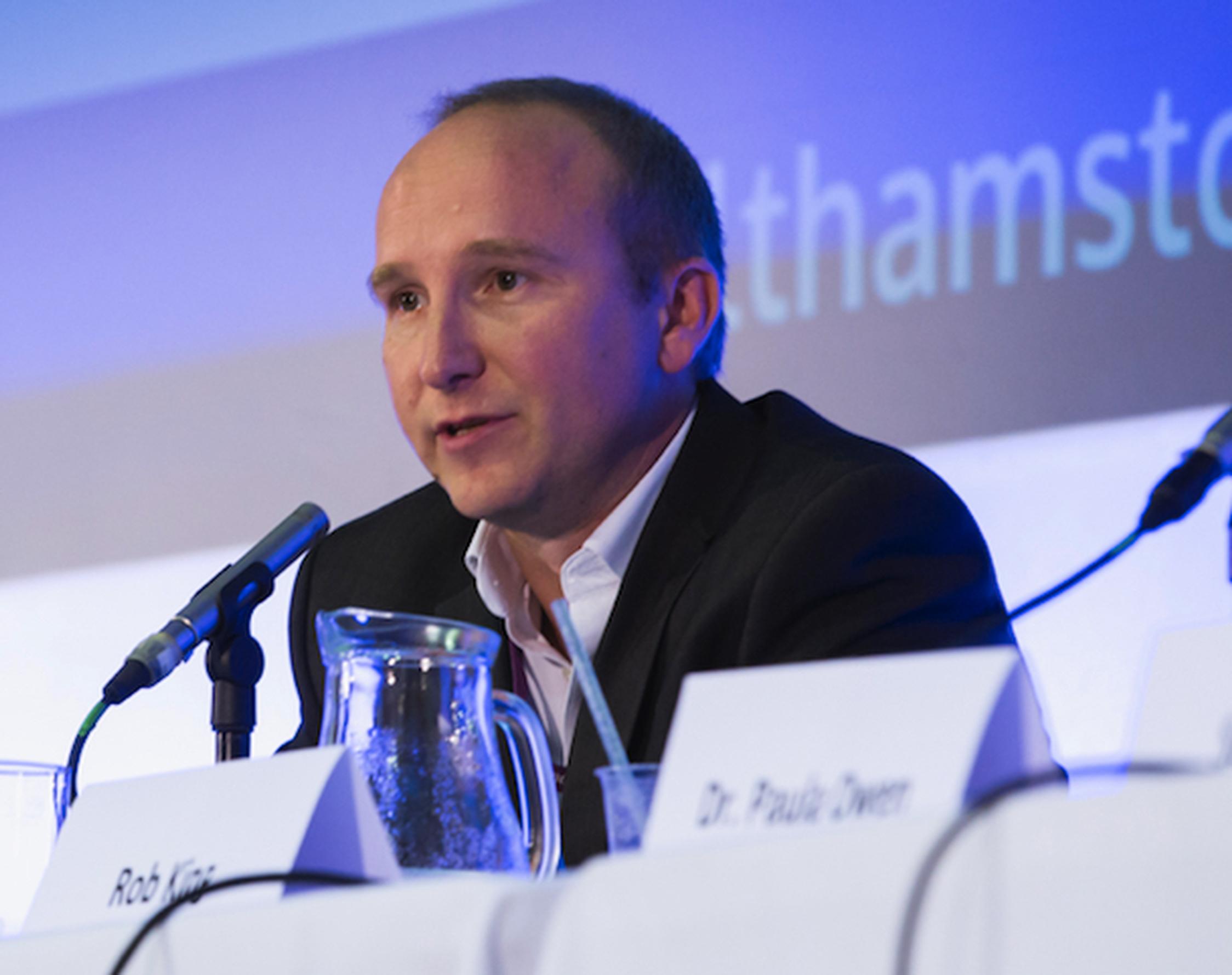



More than 300 delegates attended Healthy Streets at Walthamstow Assembly Hall last week to explore the connections between public health and transport strategies. The event, organised by Landor LINKS and hosted by Waltham Forest Council, brought together council officers, urban designers, public health specialists, transport planners, consultants, academics, equipment developers, innovators and campaigners.
The programme encompassed health-led street design, re-allocation of road space, behaviour change and measures to improve air quality. Alongside the presentations and debates, there was an exhibition representing all the elements needed to create healthy streets as well as guided cycling tours of Waltham Forest’s Mini Holland schemes.
A multi-coloured graphic that has become almost ubiquitous in the emerging healthy streets arena is the wheel showing 10 Healthy Street indicators (pictured left). So, it was fitting that the wheel’s creator was among the keynote speakers. Lucy Saunders, public health specialist, transport and the realm at Transport for London (TfL), admits she has gained a reputation for being a doom-monger.
“Many people don’t enjoy my prophesies of impeding doom or me dwelling on their impending disease and death,” she says. “Most children in London don’t play out on the street. As a result eight out of ten children in London don't even reach the bare minimum level of physical activity they need to stay healthy. This is a new phenomenon – this is the first generation of children who have been this inactive so we don't even know what it is storing up for their future.”
But Saunders insists that a better outcome is possible if streets are designed to encourage wellbeing. “The reason that public health specialists like me are so evangelical about active travel is because we know that it is the only option for the majority of people aged five to 105 to get some activity every day,” she said. “That is what we need to stay healthy. So, for us active travel is the wonder drug. Having said that, it is not easy to make it happen - we need to entice people out onto the streets, to make streets pleasant places to be. We need walking and cycling to be the better option than getting into a warm, cosy car where it is effortless to move around.”
A new streetscape is needed where people are able to connect in spaces that are not too noisy or dominated by traffic, said Saunders. “We need places where people have a reason to connect, streets where can you cycle side by side with someone else, where pavements are wide enough to put some chairs out so people can sit and chat. It means that people have an easy way of crossing the road and can travel in ways that involves human interaction.”
Will Norman, London’s cycling and walking commissioner, described the 10 Healthy Street Indicators as vital for creating “a healthy street environment that goes beyond individual streets to develop a whole transport network that encourages more cycling and walking, building 10 to 15 minute journeys into everyday routines”.
The London Mayor’s draft transport strategy is seeking to remove three million car trips a day. “We want to end car dominance on residential streets, giving pedestrians priority over vehicles,” said Norman. “We want to reduce car parking and through-traffic on smaller roads and redesign dangerous junctions so people feel safer to use them by bike and on foot.”
Ending the dominance of the car would not only reduce congestion, improve air quality and “bring about benefits in terms of physical, mental health and wellbeing, but there are also economic benefits in creating thriving local economies as well as attracting and retaining big business in London.”
Norman estimates that 6.5 million daily journeys in the capital could be cycled in less than 20 minutes. “We know the main reasons people don’t cycle is they don’t feel safe so we need to continue to build this comprehensive network of cycling routes.”
Alongside plans for more Cycle Superhighways and Quietways, London’s Walking Plan would be key in opening up active travel to more people. “As we build these routes, we want to make sure they work for cyclists and pedestrians. We know that walking has been under-valued and under-rated in terms of policy and investment over the previous years, so we are developing our Walking Plan going forward.”
The London Mayor’s proposals to improve air quality in the capital were praised by Alan Andrews, lawyer at environmental law organisation ClientEarth. He told delegates: “Sadiq Khan has really committed to making air quality an important priority for this term. He has started to set out this big vision of where we need to get to as a city. What we are doing with our work is focusing on London as a blueprint on how you address air quality.”
In November 2016 ClientEarth won a High Court case against the government over its failure to tackle illegal air pollution across the UK. Since then, ClientEarth has been pressing the government to develop a credible draft air quality plan.
“It is important that where our political leaders fail to do what they need to do we have a right to hold them to account,” said Andrews. “That is why we think that the right to breathe clean air is enshrined in legislation. We are very concerned that Brexit might undermine everything we have fought so hard to achieve, so we want to see a new clean air act for the UK .”
During the question and answer session, a member of the audience complained that his council’s local air quality management plan was “rubbish”. Andrews commented: “It is not unusual for local air quality management plans to be rubbish. In fact, you are quite lucky there is one at all - lots of local authorities don't even have one in place despite the fact they are missing air quality objectives.”
He added: “Balanced against that, though, you do have to recognise the challenges that local authorities face in terms of lack of budget; I do have some sympathies with them.”
He urged those unhappy about inaction over air quality to write to their council and “ask for clearer measures and ask what progress has been made”.
To help with this, ClientEarth is developing a tool kit, due out next year, to help people to engage with local authorities and try and put pressure on politicians, said Andrews.
A recurring theme at Healthy Streets was the need for strong political leadership in pushing through measures designed to encourage active travel. Closing roads to through-traffic can be a process fraught with opposition and angry protests, revealed Mark Frost, head of traffic and transport at the London Borough of Hounslow.
The council closed Church Street in Isleworth to through traffic in an 18-month trial in December 2015. Monitoring had shown that 66% of vehicles were through-traffic. The road was “woefully inadequate” for the amount of traffic - 3,500 vehicles a day, making space tight for pedestrians and cyclists, said Frost.
Since the closure, there has been a 45% increase in pedestrians and a 47% rise in cyclists, with pedestrians now numbering 12,000 and cyclists 740 a day, Frost reported. This had resulted in some traffic displacement onto the neighbouring Twickenham Road, but the amount of vehicles is down by 1,100 vehicles, said Frost.
Data gathered by the council for Twickenham Road showed there had been increased delays in bus journey times, but there had been no rise in collisions and air quality had improved. At the end of the trial a consultation of those living in the area found that 58% wanted Church Street re-opened to through traffic while 40% wanted it to stay closed. Despite this, Hounslow council decided to make the road closure permanent.
“The councillors were steadfast behind the closure and saw the benefits of it outweighing what they felt to be the cost of a legacy, which was a problem going back to the 1970s,” said Frost. But the Church Street scheme has damaged the prospects of other measures being introduced. “It has alienated a large amount of the community, which makes bringing in other cycling schemes quite difficult,” said Frost. “In fact, we have had to put a hold on Quietways, simply because there is so much animosity at the moment. We have won [with Church Street] but we have also built up some problems for the future.”
As for the residents of Church Street, 98% were in favour of the road closure, Frost pointed out. “The road used to be shut once a year for a street party. Now there are street parties once a month. What the resident associations say is they have opened the road to the community – they have taken it back from the cars and given it to the artisan craft market and farmers’ market, with most the revenue going to local charities.”
How to bring about mode shift in outer London boroughs was discussed by a panel from a range of disciplines, chaired by Esther Kurland, director at Urban Design London.
Simon Munk, infrastructure campaigner at the London Cycling Campaign, said Waltham Forest’s Victorian street layouts calls for creative measures to curb car use. “In Waltham Forest you are at the hard edge – what happens when you are trying to fit in a bus and a cycle track and paving? It becomes very difficult to do anything. We need to look at one-way systems and bus and cycle streets.”
He called for the introduction of dynamic road pricing “sooner rather than later”.
Munk was emphatic about the change he wants to see across outer London: “Modal filter cells on residential streets - no through traffic!”
Tompion Platt, head of policy and communication at Living Streets, acknowledged there could be tension over how space is allocated to walking or cycling. “This is down to the design not being correct - the classic example is putting a cycle lane on a footway, which will cause conflict. It won’t be a good space to cycle along and certainly not to walk. Usually there has not been a willingness to take away space from vehicles.”
Nick Lester-Davis, vice-chair at the European Road Transport Research Advisory Council, challenged suggestions that some modes should be prioritised over others. “Different roads have different purposes. What we need to do is use roads more efficiently and that means we can’t give as much space over to private cars as we used to. But it will vary between road types - if we try a ‘one size fits all’ approach then the amount of backlash and difficulty will be huge.”
He cited the attempt to ban traffic from the centre of the Norwegian capital Oslo. After protests from the city’s trade association, Oslo’s council modified its plans from having a car-free city centre to removing all on-street parking to encourage a shift to other modes.
Lester-Davis believes that increasing the cost of parking would help cut traffic. “Most councils in London heavily subsidise residential parking. It is very unlikely that any local authority is covering the full cost of residents permit schemes. So, you have authorities looking to increase the mode share of cycling and walking while at the same time using Council Tax payers’ money to subsidise car ownership, which is the minority of residents.”
It is time the true cost of motor vehicles to the environment and society is recognised, said Dr Robert Davis, chair of the Road Danger Reduction Forum. He said that the true value of different modes should be calculated. “We live in a car economy with money shovelled towards motoring. We need to think about actually paying people to walk and cycle. That is the sort of thought experiment we need to push out there. It is up to us to say, there are different forms of transport and you can use whatever you want. But you have to pay for them.”
He added: “The costs of driving in terms of space consumption, noxious emissions and danger posed to other road users can be monetised. We need to dent their sense of entitlement, and the view that cyclist are getting away with things – there is a cultural battle that needs to be fought.”
Davis also called for a crackdown on the “couple of hundred thousand” vehicles that are unregistered, uninsured and without MOTs.
Another suggestion for challenging the dominance of the car came from John Barry, head of network development for buses at Transport for London. “Town centres in London are the hubs of bus depots. In the suburbs we should make sure that bus stops are closer than parking spaces to the shops and station.”
Chair of the debate Esther Kurland pointed to what she sees as a cultural shift away from the car in the capital. “We built roads and car parks, and we wanted people to buy cars and petrol as a way of supporting the economy,” she said. “What we are seeing in London is a consumer experience based economy where the quality of place, including public spaces to enjoy yourself and spend money on coffee, is becoming more and more important. We are seeing a lot more money being spent on achieving the quality of place and the types of mobility which support that economy.”
But a true shift towards active travel modes will only become a reality with support from the top, argued Neil Taylor, director at Integrated Transport Planning. “Maybe we need transport policy to help check some of our worst impulses – take, for example, personalised on-demand food delivery services; ‘bring me food, now!’ - but change requires the decision makers to show leadership and commitment, to take those policies forward at a national level. We do not always see that happen.”
Decision makers should try to anticipate the ways in which travel behaviour will change in outer London, said Taylor. “We are dealing with legacy infrastructure from the 1970s and 1980s. The road space and how it is allocated now reflects travel behaviour as it was then. The patterns of movement in outer London are different now, and changing further. So, we need to think carefully about how we design space now to meet these evolving needs.”
TransportXtra is part of Landor LINKS
© 2025 TransportXtra | Landor LINKS Ltd | All Rights Reserved
Subscriptions, Magazines & Online Access Enquires
[Frequently Asked Questions]
Email: subs.ltt@landor.co.uk | Tel: +44 (0) 20 7091 7959
Shop & Accounts Enquires
Email: accounts@landor.co.uk | Tel: +44 (0) 20 7091 7855
Advertising Sales & Recruitment Enquires
Email: daniel@landor.co.uk | Tel: +44 (0) 20 7091 7861
Events & Conference Enquires
Email: conferences@landor.co.uk | Tel: +44 (0) 20 7091 7865
Press Releases & Editorial Enquires
Email: info@transportxtra.com | Tel: +44 (0) 20 7091 7875
Privacy Policy | Terms and Conditions | Advertise
Web design london by Brainiac Media 2020